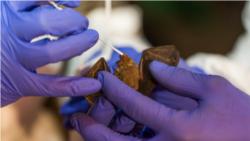Researchers from around the world are increasing efforts to find animal populations that could start future human pandemics.
The aim is to identify zoonotic diseases -- those that can spread from animals to humans.
Coronaviruses, for example, can infect both animals and humans. The U.S. Centers for Disease Control and prevention (CDC) says coronaviruses, like the new one affecting much of the world, “are common in people and many different species.”
But, the CDC notes, “animal coronaviruses rarely infect people and then spread between people.” There have, however, been major disease outbreaks caused by coronaviruses in humans.
Bats have been linked to some of them. Many scientists believe bats were the first carriers of the new coronavirus, which causes the disease COVID-19. Health experts estimate that thousands of coronaviruses are present in bats, with many still undiscovered. Researchers are seeking to identify such viruses in order to stop new ones from spreading to humans.
Dr. Gagandeep Kang is an infectious diseases expert at Christian Medical College, Vellore in southern India. She told The Associated Press (AP) “it’s not a question of if, but when” another virus will jump from animal to human and find the conditions to spread quickly.
Kang said earlier research has suggested that India is among the most likely countries for such a “spillover” event to happen. This is because India has seen its human and livestock populations increasingly expand into dense forest areas where wild animals live.
Much of the research aimed at preventing future pandemics has centered on bats, the world’s only flying mammals.
More than 1,400 different bat species live on every continent of the world except Antarctica. Many of them are effective carriers of disease. This is because the animals can carry viruses that are deadly in humans and livestock, while showing little signs of disease themselves. Experts say this permits infected bats to travel long and far, with the ability to spread viruses.
“The secret is that bats have unusual immune systems, and that’s related to their ability to fly,” Raina Plowright told the AP. She is an expert in infectious diseases and studies bats at Montana State University.
Plowright said bats require a huge amount of energy to get off the ground and stay in flight. To do this, their metabolism is raised to a very high level.
Plowright and other bat scientists think the animals’ bodies went through changes over time to help them recover from the demands of flying. Such changes could also give them extra protection against viruses. Scientists hope to keep studying the bat immune system to help them understand more about what makes the animals lose viruses. Such studies might also help researchers develop future medical treatments.
Cara Brook is a disease ecologist at the University of California, Berkeley. She said bats and other animals that carry viruses do not necessarily present a risk to humans. The right conditions have to exist for a spillover event to happen. “The virus has to come out of the host for us to get infected,” Brook said.
However, she added that the shrinking and destruction of habitats worldwide - especially in forested areas - means “we are seeing higher rates of contact between wildlife and humans.” Such contact creates more chances for spillover.
In Brazil, the state-run Fiocruz Institute sent teams to research bats in Rio de Janeiro’s Pedra Branca park, one of the world’s largest forests within a highly populated area. The park was chosen because it offers many interactions between wild animals and thousands of humans living in surrounding communities.
The scientists are not only studying bats. They are also studying small primates, wild cats and cats kept in homes with confirmed COVID-19 cases.
The Brazilian team is just one of many worldwide seeking to reduce the risk of a second pandemic this century.
Ian Mackay is a virus expert at Australia’s University of Queensland. He told the AP that scientists and governments would stand a better chance at containing future outbreaks if they had faster messaging of when and where they begin.
Mackay said ongoing, immediate, “surveillance” systems – like flu labs set up by the World Health Organization worldwide – could help researchers be better prepared. He also suggested that labs could continually test wastewater or materials from hospitals to discover new outbreaks.
I’m Bryan Lynn.
The Associated Press reported on this story. Bryan Lynn adapted the report for VOA Learning English, with additional information from the CDC. Ashley Thompson was the editor.
We want to hear from you. Write to us in the Comments Section, and visit our Facebook page.
________________________________________________
Words in This Story
species – n. a group of animals or plants that are similar and can produce young animals or plants
outbreak – n. a sudden start or increase of fighting or disease
livestock – n. farm animals
mammal – n. an animal that feeds its babies on milk from its body
immune system – n. the cells and tissues in the body that fight against infection
metabolism – n. all the chemical processes in the body, especially the ones that use food
host – n. a living animal carrying a disease
primate – n. a member of the group of animals that includes monkey and people
surveillance – n. the activity of watching someone or something very carefully












